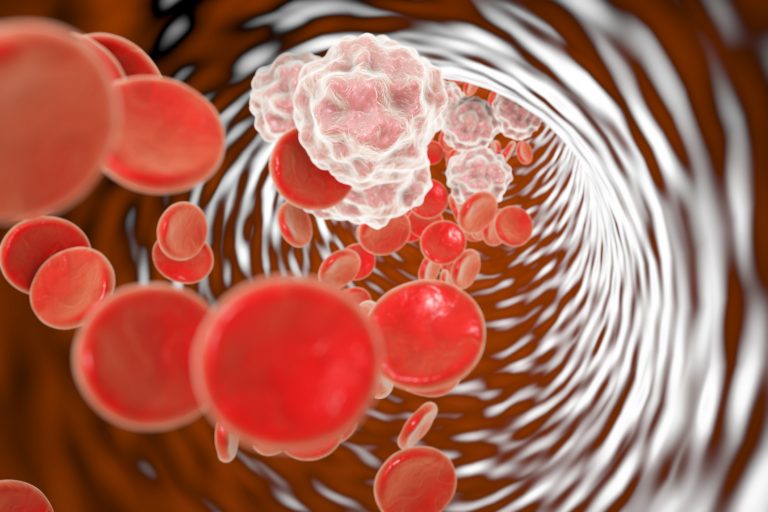
The ADA2 gene provides instructions for making an enzyme called adenosine deaminase 2. ADA2’s function has been poorly understood. Previous studies suggest that the enzyme acts as a growth factor. The enzyme also appears to be involved in the growth and development of certain immune system cells including macrophages, which are a type of white blood cell that plays a critical role in inflammation. Now researchers at the La Jolla Institute for Immunology (LJI) report that ADA2 inhibits inflammation in blood vessels. Their findings offer a potential pathway to treating DADA2, an inflammatory blood vessel disease in children that is similar to Kawasaki disease.
Their study, “Cellular sensing of extracellular purine nucleosides triggers an innate IFN-β response,” is published in Science Advances and led by Sonia Sharma, PhD, associate professor at LJI.
“This is all pretty uncharted because for a long time, this was a very misunderstood enzyme,” explained Sharma. “But we showed that the metabolic activity of this enzyme, ADA2, is very important for restraining the immune system in both vascular cells and immune cells.”
Sharma’s lab is dedicated to uncovering the earliest cellular and molecular origins of inflammation. Her work has led her to focus on stromal cells. “We think the stromal cells’ capacity for sensing early pathogenic threats is likely very important for initially coordinating and developing the magnitude, duration, and quality of the downstream immune response,” said Sharma, “and ultimately determining whether the immune response is protective or pathogenic in nature.”
The researchers observed a group of uncharacterized human disease genes linked to lupus-like autoimmune diseases that all cause multi-organ systemic inflammation or vasculitis. For the new study, the researchers asked if any of the disease-linked genes play a role in how stromal cells respond to threats by initiating an innate immune response.
Their search led them to the enzyme ADA2. “For a long time, ADA2 was ignored—no one thought it did anything,” said Sharma. “What we know now is that both ADA1 and ADA2 play a much more nuanced role in regulating the bio-activity of purine nucleosides, which are powerful signaling molecules for the immune system.”
The researchers showed that ADA2 enzyme activity naturally inhibits the innate immune response by restraining the production of a cytokine called type 1 interferon beta. Although type 1 interferon beta is a protective molecule against viral infections and cancer, overexpression of type 1 interferon beta causes harmful inflammation.
“Mechanisms linking immune sensing of DNA danger signals in the extracellular environment to innate pathways in the cytosol are poorly understood. Here, we identify a previously unidentified immune-metabolic axis by which cells respond to purine nucleosides and trigger a type I interferon-β (IFN-β) response. We find that depletion of ADA2, an ectoenzyme that catabolizes extracellular dAdo to dIno, or supplementation of dAdo or dIno stimulates IFN-β. Under conditions of reduced ADA2 enzyme activity, dAdo is transported into cells and undergoes catabolysis by the cytosolic isoenzyme ADA1, driving intracellular accumulation of dIno,” explained the researchers.
“Loss of ADA2 drives metabolic dysregulation which in turn drives immune dysregulation and inflammation, so what we ended up identifying was new immuno-metabolic axis,” stated Sharma.
A better understanding of ADA2 and purine nucleoside metabolism may lead to new therapies for treating DADA2—a recessive genetic condition, where mutations in the CECR1 gene prevent it from correctly encoding ADA2—and other types of multi-organ systemic inflammation. Sharma believes that targeting the roots of these diseases will likely require a gene therapy approach or bone marrow transplants to reconstitute ADA2 in patients who cannot make the enzyme themselves.
“dIno is a functional immunometabolite that interferes with the cellular methionine cycle by inhibiting SAM synthetase activity. Inhibition of SAM-dependent transmethylation drives epigenomic hypomethylation and overexpression of immune-stimulatory endogenous retroviral elements that engage cytosolic dsRNA sensors and induce IFN-β. We uncovered a previously unknown cellular signaling pathway that responds to extracellular DNA–derived metabolites, coupling nucleoside catabolism by adenosine deaminases to cellular IFN-β production,” noted the researchers.
“I think our study suggests the simplest treatment must be pursued to correct the metabolic dysregulation—we must reconstitute this particular enzyme activity in patients, ultimately,” Sharma stated.
Sharma’s team plans to study ADA2 function in human cells and develop in vivo models of ADA2 deficiency. Sharma sees a connection between ADA2 research and COVID-19 studies.
“We’re studying COVID patients now to see if ADA2 activity or purine nucleosides change,” explained Sharma. The team is studying how the novel coronavirus may infect stromal endothelial cells and other cells involved in stimulating the body’s innate immune response.
They are also hoping to discover how the viral pathogenesis is connected to vascular complications and Multisystem Inflammatory Syndrome in Children (MIS-C), which has similarities to Kawasaki disease and DADA2.













